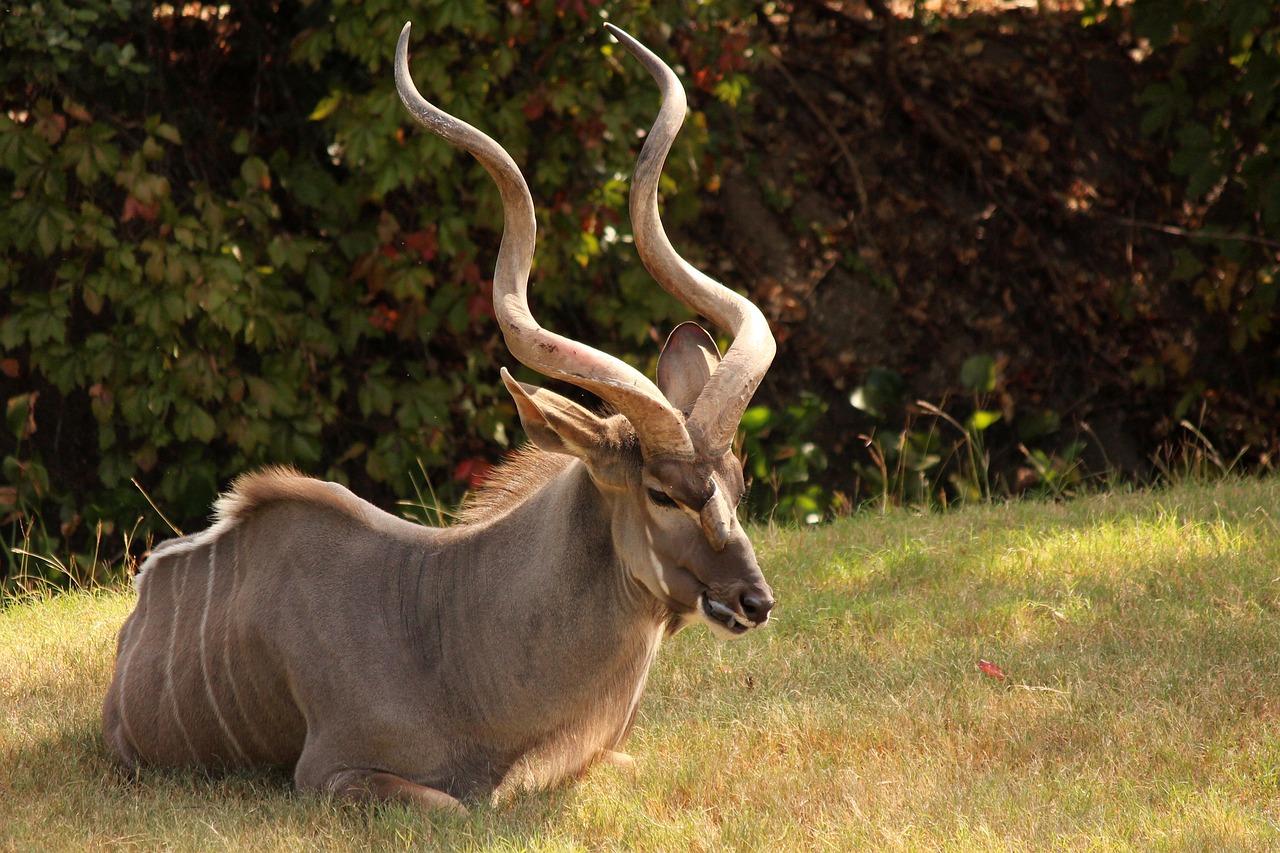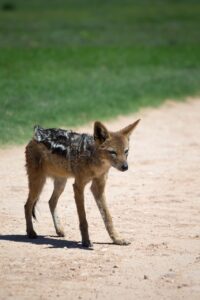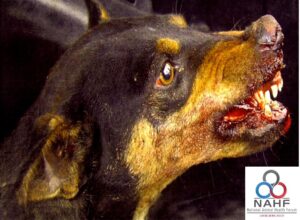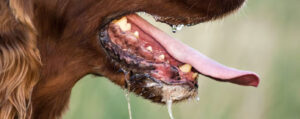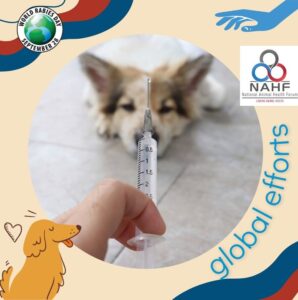An increase in the number of rabies cases among kudu has been reported in Namibia. Yet, rabies is nothing new to Namibia. The first cases of rabid kudus were reported near Windhoek in the central part of the country in the early 1970’s, from where it spread to all the major habitats of kudu in the country.
During the first epidemic between 1977 to 1986 an estimated 50 000 kudus (20% of the population) died of rabies. Rabies is caused by the Lyssavirus genus, of which rabies virus RABV is the prototype. Domestic dogs cause more than 95% of an estimate 59 000 human rabies deaths annually, with the highest incidence in Asia and Africa, where it is endemic. The disease is preventable by vaccination of domestic dogs. The rabies virus infects the central nervous system of mammals, including humans, and causes disease in the brain and ultimately death.
Notifiable disease
According to the Namibian Animal Health Act 1 of 2011, rabies is a notifiable disease and any animals that are suspected of having rabies must be reported to the Directorate of Veterinary Services (DVS) within the Ministry of Agriculture, Water and Forestry. Animals with rabies may act strangely, with some acting aggressive and trying to bite you or drool excessively, while others may act timid and tame while moving slowly. Stay away, leave them alone and report the animal to the authorities.
Occurrence in Namibia
Namibia is a large country of about 824 116 square kilometres, with about 2,1 million people. Livestock farming with cattle, sheep, and goats play an important role. While communal land with subsistence farming dominates in the Northern Communal Areas (NCAs), most commercial farms are in the central and southern parts. Namibia also has more than two million head of game which attracts tourists and trophy hunters. The game is sold as live animals or harvested for commercial meat production and onfarm use. It is therefore of the utmost importance to ensure that rabies in kudu does not spread. Due to the incidence of foot and mouth disease (FMD), a game and livestock-proof veterinary cordon fence was built in 1961/62, which is still in place. The area to the north of the fence is referred as the NCAs. The possibility of rabies spreading from the northern areas to the central and southern areas of the country has not been confirmed.
- Black-backed jackal is believed to be the major reservoir of rabies in transmitted to game animals in Namibia. (Source: Pixabay)
- Rabid animals can either be aggressive and attack you, or be misleadingly docile and tame, but equally dangerous. (Source: https://rabiesalliance.org/)
Occurrence in wildlife
Between 2011 and 2017, rabies was detected in 17 different wildlife species, mostly in kudu, followed by jackal, then eland. Other carnivores, including bat-eared foxes, aardwolf, African wild cat, African wild dog, and leopard were affected, as well as waterbuck, blue wildebeest, Kirk’s dik-dik, oryx, and roan antelope. Most wildlife rabies cases were reported from freehold farmland where cattle cases were also reported. Rabid jackals were confirmed in many parts of the country, but only sporadically from southern regions.
They were found at watering sites where they attacked cattle near farm buildings. They also attacked other domestic animals and humans. The greater kudu (Tragelaphus strepsiceros), which occurs in woodland across Southern Africa, is particularly susceptible to the disease. Since kudus are more closely related to cattle than to other animals, it is an ongoing concern as rabies in kudu threatens the livelihoods of farmers in the NCAs as well as on commercial farms in the central and southern parts.
Distribution of cases
Namibia is aiming to control the main reservoir of the disease, namely domestic dogs, by a mass vaccination drive of dogs, especially in the NCAs. Research done from 2011 to 2017 indicated that most cases of rabid dogs (77%) were reported in the NCAs, followed by 17% in urban areas and 3% on freehold or privately owned farms. Most cases of rabies in humans (113) were also reported in the NCAs over the same period. The number of rabies cases among cattle were equally distributed between communal farmland and freehold farms.
The incidence of rabies in kudu, however, was mainly reported on farms in the central part of the country, where 67% of all samples tested rabies-positive. Kudu had the highest positivity rate, followed by jackal (87%). While dogs seem to be the reservoir for rabies in the NCAs, jackals, and bateared foxes to some extent, seem to be the reservoirs in the central and southern parts where kudu and eland are mostly affected. While dogs can be controlled, control of wild animals is not possible.
In humans
It is however dog-related rabies that contribute the most to rabies in humans, who needs costly post-exposure prophylaxis (PEP) to treat. If not treated in time, humans die.
The country has initiated a national control strategy towards ending human dog-mediated deaths by 2030, which is in line with international efforts to eradicate the disease.
- Excessive salivation, or ‘foaming at the mouth’, is a typical sign of rabies. (Source: https://rabiesalliance.org/)
- Rabies can be controlled and even eliminated if a strict vaccination protocol is followed. (Source: https://rabiesalliance.org/)
Surveillance
Surveillance of the disease in animals is based on the reporting of all suspected cases in any species to an official of the DVS, recording of all relevant information on a specific Disease Report Form (DRF) and submission of the latter to the Epidemiology Section of the DVS. Dog samples must also be submitted when associated with a human bite. Dog bite cases and potential exposure to rabies must be reported to the nearest state veterinary official, who will assess the rabies vaccination status of the animal. If no vaccination certificate can be produced, the dog is quarantined and if it shows signs of rabies, it is euthanised.
If a laboratory confirms rabies, the bite victim is treated free of charge at the nearest clinic. Human deaths caused by rabies mostly occur in children (67%) between five and nine years of age, with mostly males (62%) between the ages of 15 and 19.
Population density
Research found that dogs accounted for one third of all diagnosed rabies cases and that there was a correlation between human density and the incidence thereof. Rabies in livestock animals also increased with increasing density in numbers in the NCAs. Kudu, however, is not positively linked to human population density.
Seasonal occurrence
Rabies cases in dogs, livestock and wildlife have a higher positivity rate in the rainy season during the first part of the year. Kudu cases of rabies infection peaked in March and July. Since the incubation period range from 12 to 250 days, the animals could have been infected during the hot, dry season from September to December. In the NCAs, the trend may be the result of seasonal movement of livestock including guarding dogs. These dogs are sometimes temporarily abandoned, which could lead to interaction with infected animals. In Zimbabwe, the incidence of jackal rabies peaked during June to August and December to May, which could be explained by the social behaviour and population dynamics of jackals.
Animals and Rabies (2022) Centres for disease control and prevention https://www.cdc.gov/rabies/animals/index.html
An update on rabies in South Africa (2021) Communicable Diseases Communiqué December 2021, Vol. 20 (12) https://www.nicd.ac.za/wpcontent/uploads/2021/12/An-updateon-rabies-in-South-Africa-2021.pdf
Dorfling, C. (2024) Hondsdolheidgeval in Gqeberha bevestig, maar gevalle neem af https://www.netwerk24.com/netwerk24/nuus/aktueel/hondsdolheid-geval-in-gqeberha-bevestigmaar-gevalle-neem-af-20240110
Namibia’s battle against rabies: a One Health success story. (n.d.) World Organisation for Animal Health https://www.woah.org/en/article/namibias-battle-against-rabies-aone-health-success-story/
Streicker, D.G. (Ed) (2019) Ecology and epidemiology of rabies in humans, domestic animals and wildlife in Namibia, 2011-2017 PLoS Negl Trop Dis. 2019 Apr; 13(4): e0007355. Published online 2019 Apr 16. doi: 10.1371/journal.pntd.0007355 PMCID: PMC6486109 PMID: 30990805 https://www.ncbi.nlm.nih.gov/pmc/articles/PMC6486109/
Van Rooyen, C. (2023) Hondsdolheid neem toe onder koedoes in Namibië https://www.landbou.com/landbou/bedrywe/diere/hondsdolheid-neemtoe-onder-koedoes-20240301

